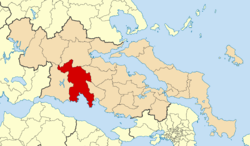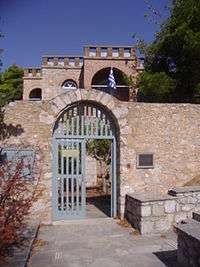Delphi (modern town)
The modern town of Delphi (/ˈdɛlfaɪ/ or /ˈdɛlfi/; Greek: Δελφοί, [ðelˈfi]) is situated immediately west of the archaeological site of the same name, and hence is a popular tourist destination. Delphi is also the name of the modern-day municipality in which the town of Delphi is situated. The city of Delphi was named after the Oracle of Delphi, who supposedly foretold the future.
Delphi Δελφοί | |
|---|---|
 Delphi Location within the region  | |
| Coordinates: 38°28′47″N 22°29′38″E | |
| Country | Greece |
| Administrative region | Central Greece |
| Regional unit | Phocis |
| Government | |
| • Mayor | Athanasios Panagiotopoulos (since 2014) |
| Area | |
| • Municipality | 1,121.7 km2 (433.1 sq mi) |
| • Municipal unit | 73.13 km2 (28.24 sq mi) |
| Elevation | 632 m (2,073 ft) |
| Population (2011)[1] | |
| • Municipality | 26,716 |
| • Municipality density | 24/km2 (62/sq mi) |
| • Municipal unit | 1,767 |
| • Municipal unit density | 24/km2 (63/sq mi) |
| Community | |
| • Population | 1,024 (2011) |
| Time zone | UTC+2 (EET) |
| • Summer (DST) | UTC+3 (EEST) |
| Vehicle registration | ΑΜ |
Town
It is on a major highway linking Amfissa along with Itea and Arachova. There are many hotels and guest houses in the town, and many taverns and bars. The main streets are narrow, and often one-way. The E4 European long distance path passes through the east end of the town. In addition to the archaeological interest, Delphi attracts tourists visiting the Parnassus Ski Center and the popular coastal towns of the region.
In the Middle Ages a town called Kastri was built on the archaeological site. The residents had used the marble columns and structures as support beams and roofs for their improvised houses, a usual way of rebuilding towns that were partially or totally destroyed, especially after the earthquake in 1580, which demolished several towns in Phocis. In 1893 archaeologists from the École française d'Athènes finally located the actual site[2] of ancient Delphi and the village was moved to a new location, west of the site of the temples.
Municipality
The municipality Delphi was formed at the 2011 local government reform by the merger of the following 8 former municipalities, that became municipal units:[3]
The municipality has an area of 1121.671 km2, the municipal unit 73.126 km2.[4] The administrative seat of the municipality is in the largest town, Amfissa. The total population of the municipality is 32,263. The town Delphi has a population of 2,373 people while the population of the municipal unit of Delphi, including Chrisso (ancient Krissa), is 3,511.[3]
See also
- Franz Weber (activist) - made an honorary citizen of Delphi in 1997
- List of traditional Greek place names
Gallery
 House of Angelos Sikelianos
House of Angelos Sikelianos Saint Nicolas church
Saint Nicolas church Town hall
Town hall.jpg) Building and view into valley
Building and view into valley.jpg) Valley and road sign
Valley and road sign.jpg) Entrance flags
Entrance flags.jpg) Fence and valley
Fence and valley Olive trees and water aqueduct in Delphi valley
Olive trees and water aqueduct in Delphi valley
References
- "Απογραφή Πληθυσμού - Κατοικιών 2011. ΜΟΝΙΜΟΣ Πληθυσμός" (in Greek). Hellenic Statistical Authority.
- (see link)
- Kallikratis law Greece Ministry of Interior (in Greek)
- "Population & housing census 2001 (incl. area and average elevation)" (PDF) (in Greek). National Statistical Service of Greece. Archived from the original (PDF) on 2015-09-21.
External links
| Wikimedia Commons has media related to Delphi (town). |
- Homepage of the modern municipality (in English and Greek)
- European Cultural Centre of Delphi
